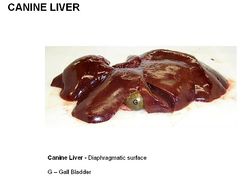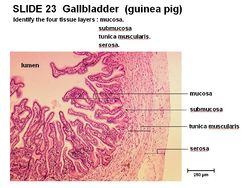Difference between revisions of "Gall Bladder - Anatomy & Physiology"
Fiorecastro (talk | contribs) |
|||
| (33 intermediate revisions by 9 users not shown) | |||
| Line 1: | Line 1: | ||
| − | + | {{OpenPagesTop}} | |
| − | |||
==Introduction== | ==Introduction== | ||
| − | The | + | The gall bladder stores bile produced in the [[Liver - Anatomy & Physiology|liver]]. Bile is important in the digestion of lipids. |
| − | The | + | The gall bladder forms as an outgrowth of the bile duct, as a secondary hollow at the posterior edge of the original hepatic rudiment. The '''cystic duct''' joins the common bile duct which enters the [[Duodenum - Anatomy & Physiology|duodenum]] at the major '''duodenal papillae''' (with the pancreatic duct) on the dorsal surface of the [[Duodenum - Anatomy & Physiology|duodenum]]. |
==Structure== | ==Structure== | ||
| − | [[Image:Canine Gallbladder Anatomy.jpg|thumb|right| | + | [[Image:Canine Gallbladder Anatomy.jpg|thumb|right|250px|Location of the Canine Gallbladder - Copyright RVC 2008]] |
| − | + | The gall bladder lies between the right medial and quadrate lobes of the [[Liver - Anatomy & Physiology|liver]]. It is partly attached and partly free. | |
| − | |||
| − | |||
| − | |||
| − | |||
| − | |||
==Function== | ==Function== | ||
| − | + | The gall bladder stores bile and concentrates bile by absorption through the folded mucosal wall. | |
| − | |||
| − | |||
| − | |||
==Innervation== | ==Innervation== | ||
| − | + | The gall bladder is innervated by parasympathetic nerves. | |
| + | ==Species Differences== | ||
| − | + | '''Equine''' | |
| + | Equine species have no gallbladder. | ||
| − | + | '''Rodents''' | |
| − | |||
| − | + | There is no gallbladder in rats. | |
| − | + | '''Canine''' | |
| − | + | The gall bladder lies opposite the 8th intercostal space. It has the thinnest layers of tunica muscularis. | |
| − | + | '''Bovine''' | |
| + | The bovine gall bladder has the thickest layers of the tunica muscularis. Sheep have a less projecting gall bladder than cows. The gallbladder lies against the 10th or 11th rib. | ||
| − | + | '''[[Avian Digestive Tract - Anatomy & Physiology|Avian]]''' | |
| − | ''' | + | '''Pigeons''' and '''parrots''' lack a gallbladder. |
| − | |||
| − | + | ==Histology== | |
| − | |||
| − | ''' | + | [[Image:Guinea-pig Gallbladder Hsitology.jpg|thumb|right|250px|Histology of the Guinea-pig Gallbladder - Copyright RVC 2008]] |
| − | + | The gall bladder has a highly folded '''mucosa'''. It has a reduced '''submucosa''' and no '''lamina muscularis'''. The gall bladder has a simple columnar epithelium and no glands present. | |
| − | + | ==Links== | |
| − | + | '''Click here for [[:Category:Gall Bladder and Tract - Pathology|pathology of the Gall Bladder]]''' | |
| − | + | {{Template:Learning | |
| − | + | |flashcards = [[Liver - Anatomy & Physiology - Flashcards|Liver & Gall Bladder]] | |
| − | + | |powerpoints = [[Gastrointestinal Tract Histology resource|Histology of the gall bladder - see part 2]] | |
| − | + | |videos = [[Video: Bovine liver potcast|Bovine liver potcast]]<br>[[Video: Bovine liver potcast 2|Bovine liver potcast 2]]<br>[[Video: Ventral view of the pancreas and small intestine potcast|Ventral view of the pancreas and small intestine potcast]]<br>[[Video: Bovine pregnant uterus potcast 2|Bovine pregnant uterus potcast 2]]<br>[[Video: Ovine right-sided abdominal and thoracic dissection|Ovine right-sided abdominal and thoracic dissection]] | |
| − | + | |Vetstream = [https://www.vetstream.com/canis/Content/Freeform/fre60060.asp Gall bladder disease] | |
| − | + | }} | |
| − | |||
| − | |||
| − | [[Liver | + | ==Webinars== |
| + | <rss max="10" highlight="none">https://www.thewebinarvet.com/gastroenterology-and-nutrition/webinars/feed</rss> | ||
| + | [[Category:Liver and Gall Bladder - Anatomy & Physiology]] | ||
| + | [[Category:A&P Done]] | ||
Latest revision as of 15:07, 25 November 2022
Introduction
The gall bladder stores bile produced in the liver. Bile is important in the digestion of lipids.
The gall bladder forms as an outgrowth of the bile duct, as a secondary hollow at the posterior edge of the original hepatic rudiment. The cystic duct joins the common bile duct which enters the duodenum at the major duodenal papillae (with the pancreatic duct) on the dorsal surface of the duodenum.
Structure
The gall bladder lies between the right medial and quadrate lobes of the liver. It is partly attached and partly free.
Function
The gall bladder stores bile and concentrates bile by absorption through the folded mucosal wall.
Innervation
The gall bladder is innervated by parasympathetic nerves.
Species Differences
Equine Equine species have no gallbladder.
Rodents
There is no gallbladder in rats.
Canine
The gall bladder lies opposite the 8th intercostal space. It has the thinnest layers of tunica muscularis.
Bovine
The bovine gall bladder has the thickest layers of the tunica muscularis. Sheep have a less projecting gall bladder than cows. The gallbladder lies against the 10th or 11th rib.
Pigeons and parrots lack a gallbladder.
Histology
The gall bladder has a highly folded mucosa. It has a reduced submucosa and no lamina muscularis. The gall bladder has a simple columnar epithelium and no glands present.
Links
Click here for pathology of the Gall Bladder
| Gall Bladder - Anatomy & Physiology Learning Resources | |
|---|---|
To reach the Vetstream content, please select |
Canis, Felis, Lapis or Equis |
 Test your knowledge using flashcard type questions |
Liver & Gall Bladder |
 Selection of relevant videos |
Bovine liver potcast Bovine liver potcast 2 Ventral view of the pancreas and small intestine potcast Bovine pregnant uterus potcast 2 Ovine right-sided abdominal and thoracic dissection |
 Selection of relevant PowerPoint tutorials |
Histology of the gall bladder - see part 2 |
Webinars
Failed to load RSS feed from https://www.thewebinarvet.com/gastroenterology-and-nutrition/webinars/feed: Error parsing XML for RSS

